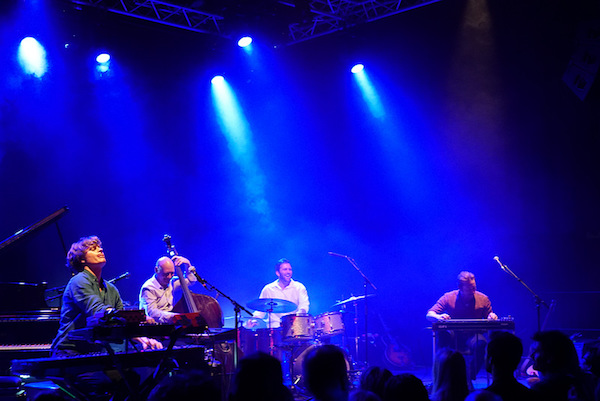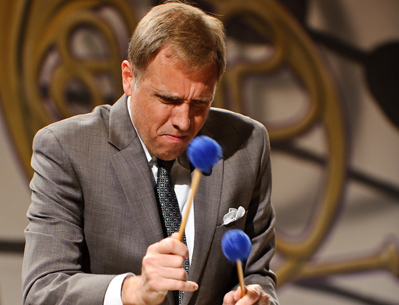Dec 9, 2025 12:28 PM
In Memoriam: Gordon Goodwin, 1954–2025
Gordon Goodwin, an award-winning saxophonist, pianist, bandleader, composer and arranger, died Dec. 8 in Los Angeles.…

Bassist Dan Berglund (second from let) performs with his bandmates in Tonbruket at Studion Kulturhuset during the Stockholm Jazz Festival on Oct. 7.
(Photo: Heiko Purnhagen 2017 )Born in the remote village of Pilgrimstad, Sweden (population: 386), bassist Dan Berglund is a musical institution on the Swedish jazz scene. He rose to fame as a member of the very popular Esbjorn Svensson Trio, or e.s.t., which he was in from 1993 until 2008 (when pianist Esbjorn died). Berglund went on to form a new band, Tonbruket, which performed at this year’s Stockholm Jazz Festival.
Since 2010, the ACT label has released four albums from the band: Dan Berglund’s Tonbruket, Dig It To The End, Nubium Swimtrip and Forevergreens.
A musician equally familiar with Swedish folk music, pop, rock and techno, Berglund, 54, has also worked with large ensembles, including the “28-piece behemoth” Fire Orchestra and symphony orchestras, including the e.s.t. symphony, a project re-creating symphonic music based on e.s.t. compositions.
DownBeat sat backstage with Berglund prior to Tonbruket’s gig at the club Studion, Kulturhuset, Stadsteatern, on Oct 7.
What were the origins of the Esbjorn Svensson Trio?
In 1993, I used to play in restaurants here in Stockholm with many different musicians, playing standards. And then Esbjorn, who I met working together with singer Lina Nyberg, asked, “Can you play with me on Saturday?” And I said, “Of course. Love to.” “And, by the way, [future e.s.t. drummer] Magnus [Ostrom] is going to join us.” [I said,] “Ah, OK. Very nice.”
I didn’t think about it, but it was much more than a gig. But [the club owners] slammed it. It was like an “audition” for them. But, after some weeks, Esborn asked me if I wanted to join the trio.
During your time in e.s.t., how would you say your playing evolved?
I was a good bass player when I met Esbjorn. Otherwise, he wouldn’t have me [chuckles]. I learned a lot working with the trio. One thing he said: “Don’t play too much. You don’t have to play so much. Just one note.” I was a little bit busy. I listened a lot to Niels-Henning Orsted Pedersen and guys like that.
Up and down, up and down.
[laughs] Yeah, yeah. And probably listening to others like Charlie Haden, who is like the opposite of Niels-Henning. I really loved him. I used to play a lot with a bow, actually.
With e.s.t., you started to change the nature of the jazz trio. Did the playing became more modal for you, as compared to your previous bands?
That’s right. And the trio was not only into jazz. I’m a hard-rock fan. That’s what I really like. So, that’s when I started to experiment with the bow and distortion on the bass, to sound like Jimi Hendrix or Ritchie Blackmore.
Let’s talk about the name Tonbruket. Is that an actual word or did you make it up?
Yeah, we made it up. But “ton” means a note, or a sound; and “bruket,” it’s like a factory.
Was Tonbruket formed soon after e.s.t., or did it take a while?
The guitar player, Johan Lindstrom, called me and asked me how I was after the death of Esbjorn and the end of e.s.t. It was a really hard time. But then we decided we should do something together. When we started we didn’t know what kind of music we were going to do, what instruments we’re going to have in the group.
Then we talked about who we were going to ask to join the band. We thought about having a cello player. And then I met Martin [Hederos], the piano player, at the Grammy festival here in Sweden in 2009. And then, [drummer] Andreas [Werliin]. I checked him out on YouTube and records that he’s played on, and really liked him. So I called him. It was not like we had actually booked a studio for a recording; so, we rehearsed for one-and-a-half days and then we entered the studio.
How would you describe Tonbruket’s music?
I wanted to have a group of musicians who weren’t just into jazz. None of them were, actually, at that time. They were playing pop and rock. We just came with songs, all of us, and just recorded it. We didn’t really know what direction we wanted to go in.
I think on the first album [Dan Berglund’s Tonbruket, ACT, 2010], we were more into rock than jazz. And then, more and more, we started to involve more classical music, more classical harmonies, like from Shostakovich. As for the folk music, most of that comes from Johan. His writing [is] more like folk-music style.
How much of Tonbruket’s music is improvised?
A lot. In the beginning, it was kind of difficult to do, because they weren’t used to doing that.
Back then, was it more song-oriented playing?
That’s right. But nowadays, if you compare e.s.t. with Tonbruket, that’s something I took Tonbruket to—to improvise a lot. Between the songs, we jam and then we go to the next song.
You’re involved with side projects like the Fire Orchestra and the e.s.t. symphony, but Tonbruket is your top priority?
Yeah, my heart is in Tonbruket.
(For info on Tonbruket, visit the band’s website and the website of its label, ACT). DB

Goodwin was one of the most acclaimed, successful and influential jazz musicians of his generation.
Dec 9, 2025 12:28 PM
Gordon Goodwin, an award-winning saxophonist, pianist, bandleader, composer and arranger, died Dec. 8 in Los Angeles.…

Belá Fleck during an interview with Fredrika Whitfield on CNN.
Jan 13, 2026 2:09 PM
The fallout from the renaming of the John F. Kennedy Center for the Performing Arts to include President Donald…

Flea has returned to his first instrument — the trumpet — and assembled a dream band of jazz musicians to record a new album.
Dec 2, 2025 2:01 AM
After a nearly five-decade career as one of his generation’s defining rock bassists, Flea has returned to his first…

Dec 11, 2025 11:00 AM
DownBeat presents a complete list of the 4-, 4½- and 5-star albums from 2025 in one convenient package. It’s a great…

Vibraphonist Chuck Redd found himself in the midst of a political firestorm after canceling his gig Dec. 24 at the newly renamed Trump Kennedy Center.
Jan 6, 2026 2:32 AM
The Board of Trustees at Washington, D.C.’s Kennedy Center for the Performing Arts voted on Dec. 18 to rename the…